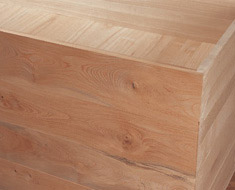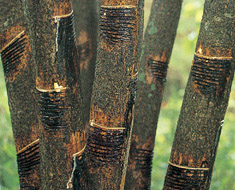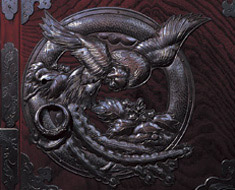Materials
WoodIwayadō Tansu are made from zelkova and paulownia wood. Lacquering brings out the gorgeous wood grain of zelkova, providing an opulent base for the metal fittings. The interior of the drawers is fashioned from paulownia, which protects the contents from moisture and humidity. |
 |
LacquerLacquer is a beautiful, durable, natural finish that accentuates the grain of the zelkova wood exterior. Natural lacquer is brushed on, and excess removed with a cloth. This process is repeated over and over until a final coat is applied. Over time, the lacquer becomes more transparent, increasing each piece’s luxuriant appearance. |
 |
FittingsThese metal fittings are perhaps the most recognizable and distinguishing feature of Iwayadō Tansu. There are two types. The first are cast iron, drawing from the region’s famous Nambu Tekki ironware tradition. The second are hand-wrought, chiseled and hammered from iron or copper plates. The designs for these handcrafted fittings are first rendered on paper, and then overlaid on the fittings to repoussé. * Nambu Tekki: The famous ironware tradition of Iwate Prefecture’s Morioka and Ōshū City areas. |
 |
Production
Wood is the life of our furniture. They are still made entirely by hand by a single craftsperson. Seasoned timber is carved, assembled, and lacquered by hand to highlight the rich zelkova grain. When the metal fittings are applied to this sensuous wood base, the piece is complete. At this point, it leaves the craftsman’s hands as an item of exceptional functional beauty.
* The grain of each piece will vary with the zelkova and paulownia timber used.
* Lacquer is darkest when first applied, but gradually becomes more transparent.
* There is minor variation in the dimensions of our handmade furniture.
* The cast (Nambu Tekki) fittings are blackish, but may appear silver in photographs due to the flash.
* The timber used in Iwayadō Tansu meets the most stringent Japanese formaldehyde emission standards for building materials (JIS/JAS F****).
Lacquer “breathes,” expanding and contracting with the ambient humidity. Wood is likewise “alive,” responding to the environment. Because of this, your chest will change over time. The lacquer will develop depth, luster, and clarity, bringing out the swirling wood grain.
